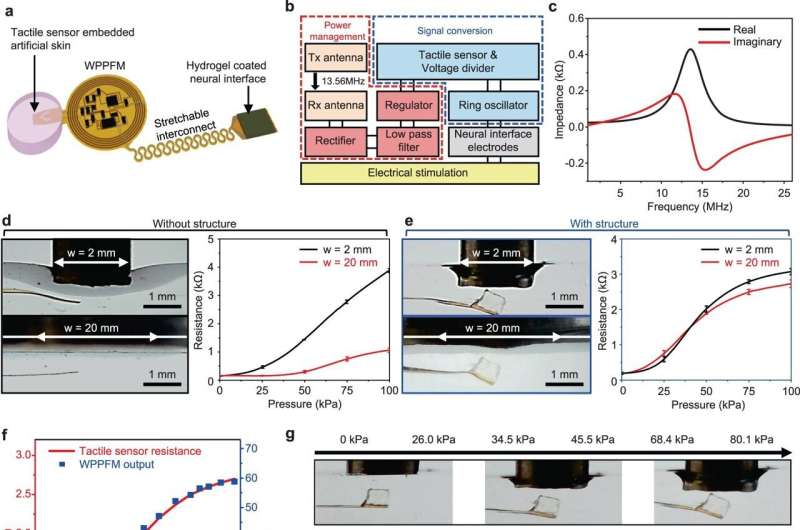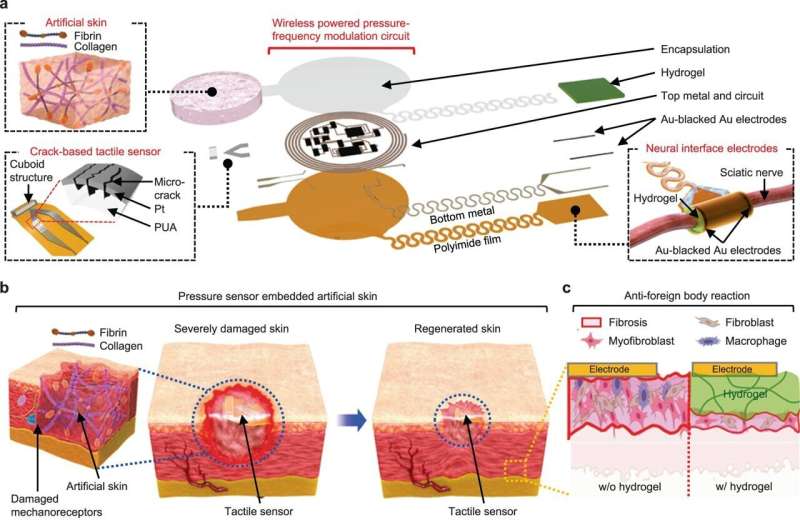This article has been reviewed according to Science X's editorial process and policies. Editors have highlighted the following attributes while ensuring the content's credibility:
fact-checked
peer-reviewed publication
trusted source
proofread
Developing artificial skin that can regenerate skin and transmit sensation at the same time

Damage to nerve tissue due to skin defects such as burns, skin diseases, and trauma causes loss of sensory and cognitive functions that are essential for life-sustaining activities, as well as mental and physical distress. If the damage is severe enough that natural healing is not possible, surgical treatment is required to implant artificial skin in the affected area, but the artificial skin developed to date has focused on skin regeneration, providing a structure and environment similar to skin tissue, but has not restored sensation to patients.
A research team led by Dr. Youngmee Jung of the Center for Biomaterials and Dr. Hyunjung Yi of the Post-Silicon Semiconductor Institute, in collaboration with Prof. Ki Jun Yu of Yonsei University and Prof. Tae-il Kim of Sungkyunkwan University, has developed a human-implantable tactile smart bionic artificial skin. The work is published in the journal Nature Communications.
Unlike conventional artificial skin, which focuses on skin regeneration, smart bionic artificial skin can restore even permanently damaged tactile senses by fusing biocompatible materials and a tactile function delivery system implemented with electronic devices.
The artificial skin developed by the team is a hydrogel composed of collagen and fibrin, the main components of skin, that can detect even small pressure changes by inserting crack-based tactile sensors.
The sensed pressure changes are converted into electrical signals, via a wireless powered pressure-frequency modulation (WPPFM) circuit, which are then transmitted to the nerves by tactile nerve interfacing electrodes, allowing the device to perform the same tactile functions as the skin.

The researchers also found that collagen and fibrin, which are responsible for skin's elasticity and tissue connectivity, trigger the proliferation and differentiation of skin cells around the wound to promote skin regeneration.
The smart bionic artificial skin was implanted into rats with severe skin damage to test its effectiveness in promoting skin regeneration and reestablishing tactile function, and it showed a wound healing effect of more than 120% compared to the control group at 14 days after implantation. In addition, it detected external changes in the pressure range of 10 to 40 kPa, which is similar to the pressure range felt by human fingertips, and adjusted the electrical signals accordingly to change the rat's response.
In particular, the artificial skin developed by the researchers is effective for sensory transmission and skin regeneration because it is implanted directly into the nerves along the subcutaneous fat layer of the damaged skin.
After skin regeneration in patients with nerve damage, tactile sensors can operate in the subcutaneous layer, greatly improving independence in daily life. Even in the case of elderly people with degenerated sensory functions, it is expected that the degenerated sensory functions can be restored by directly inserting tactile electronic devices made with high-density integration technology into the subcutaneous layer.
"This research is the result of convergence research on devices, materials, and regenerative medicine that effectively combines biomaterials and electronic device technology," said Dr. Youngmee Jung of The Korea Institute of Science and Technology.
"We plan to conduct additional clinical trials in collaboration with medical institutions and companies for commercialization, and we also plan to expand our research to reconstruct various functions of skin tissue such as temperature, vibration, and pain."
More information: Kyowon Kang et al, Bionic artificial skin with a fully implantable wireless tactile sensory system for wound healing and restoring skin tactile function, Nature Communications (2024). DOI: 10.1038/s41467-023-44064-7




















